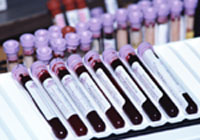 |
 |
 |
 |
|||
 |
||||||
|
Transmission HIV can only survive in body fluids, and is transmitted by blood, semen, vaginal fluid and milk. The disease can be contracted in the following ways: Intimate sexual contact The disease was first associated with homosexual communities, notably in American cities such as San Francisco. Infected
blood entering the blood stream The disease can be contracted through receiving blood or blood products already infected with HIV. This was the case for some haemophiliacs who were given factor VIII from infected blood. Extensive screening programmes have been able to largely remove this threat in countries with adequate medical facilities. It is also possible to contract the disease through contaminated needles used for intravenous drug delivery. From mother to baby An infected pregnant woman can pass on the virus to her baby through the placenta, at birth or through breast milk. The chances of the infection being transmitted from the mother to her baby are estimated to be 25-50%. This can largely be prevented by treating infected pregnant women with the drug zidovudine (AZT). Most, but not necessarilly all, individuals infected with HIV progress over time to AIDS. The following stages of the disease can be seen: 1. The initial infection with HIV may produce a short flu-like illness, but often gives no symptoms. 2. The second stage is the period between infection and the onset of clinical signs (HIV-positive phase). It generally lasts between 2 and 15 years. Although no symptoms are seen this period is not static, there is persistent replication of the virus and a gradual decline in function and numbers of CD4 T cells. 3. The third phase sees the onset of opportunistic infections, which at this point are not major. Common bacterial, viral and fungal infections occur. Oral and genital herpes or athlete's foot are common examples. The duration of this type of infection is lengthened compared to that in a healthy person. Loss of weight may also be seen. There is a significant drop in the number of CD4 T cells. 4. Onset of AIDS-Opportunistic infections (protozoal, viral, bacterial or fungal), disease of body organs and development of secondary cancers are common and life-threatening. Some individuals may lose a great deal of weight.
|
